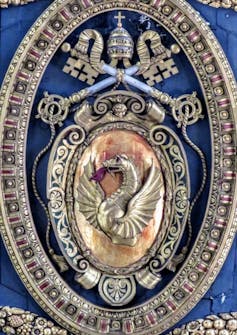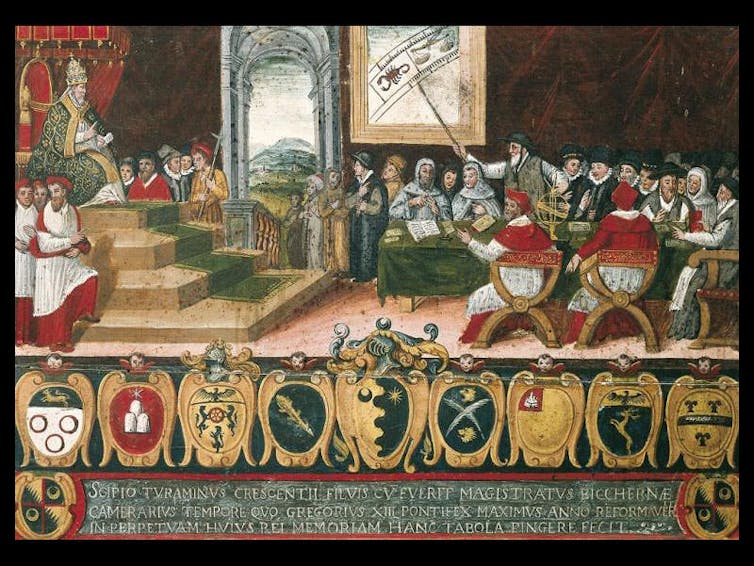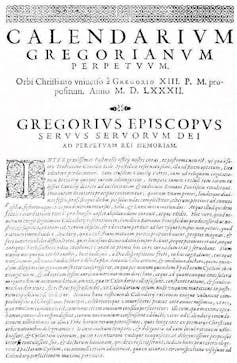On this present day, February 29, conversations the world over may conjure the name of Pope Gregory XIII – widely known for his reform of the calendar that bears his name.
The need for calendar reform was driven by the inaccuracy of the Julian calendar. Introduced in 46 BC, the Julian calendar fell in need of the solar yr – the time it takes Earth to orbit the Sun – by about 12 minutes every year.
To correct this, Gregory convened a commission of experts who fine-tuned the leap-year system, giving us the one we have now today.
But the Gregorian calendar isn’t the one legacy Pope Gregory left. His papacy encompassed a broad spectrum of achievements which have left a long-lasting mark on the world.
Rise to papacy
Born in 1502 as Ugo Boncompagni, Gregory made many contributions to the lifetime of the Catholic Church, the town of Rome, education, arts and diplomacy.
Before ascending to the papacy, Boncompagni had a distinguished profession in law in Bologna where he received his doctorate in each civil and canon law. He also taught jurisprudence, which is the speculation and philosophy of law.
Wikimedia
His mental influence positioned him as a trusted figure in legal and diplomatic circles even before his election as pope within the 1572 conclave. Upon being elected he adopted the name Gregory, in honour of Pope Gregory the Great who lived within the sixth century.
Movement within the Church
One of Gregory’s major undertakings was reforming the Catholic Church in response to the Reformation, a movement which established a definite latest branch of Christianity, Protestantism, separated separate from the Catholic Church.
Read more:
Revisiting the Reformation: how passions sparked a spiritual revolution 500 years ago
Gregory aimed to implement the selections of the Council of Trent, which met between 1545 and 1563, and defined key Christian doctrines and practices, including scripture, original sin, justification, the sacraments and saint veneration. Its outcomes directed the church’s future for hundreds of years.
Gregory’s administrative reforms were aimed toward centralising church governance and its operations. As pope, he relished the practice of law, personally engaging in judicial deliberations and surprising his contemporaries along with his legal acumen.
His papacy also marked a revision of Gratian’s Decretals, a group of Twelfth-century church laws that served as a textbook for lawyers. Gregory aimed to correct quite a few errors and unify the varied versions of this foundational text of canon law. This culminated within the publication of an amended edition in 1582.
Gregory’s dragon
Pope Gregory lived at a time when emblematic and symbolic interpretations were central to the political and cultural discourse. In particular, monsters were interpreted as omens or divine signs and played a major role in religious and political debate.
Gregory’s coat of arms, the heraldic emblem of the Boncompagni family, featured a dragon. As such, it drew criticism from Protestant propaganda.

Wikimedia
Anti-Catholic publications featured the Boncompagni dragon as an emblem of the Antichrist, drawing on the seven-headed monster within the Book of Revelation.
Rooted in biblical and mythological references, the negative imagery of Gregory’s dragon became a focus for debates over the character of papal authority, the legitimacy of Protestant criticisms, and the broader struggle to define truth and meaning in a rapidly changing world.
A legacy enshrined in art
Gregory’s legal legacy is widely known in art, particularly within the Sala Bologna of the Vatican Palace, which commemorates his and other popes’ contributions to the study and codification of law.
Gregory XIII’s pontificate (term of office) was marked by a comprehensive effort to renew and beautify Rome, improving each the town’s functionality and aesthetics. He had a selected give attention to the Capitoline Hill, the political and non secular heart of Rome because the Antiquity.
Gregory’s initiatives – which included restoring essential infrastructure reminiscent of gates, bridges and fountains – were a part of a broader vision to stress the centrality of law in Rome’s history and culture.
This is demonstrated by him being honoured by a statue within the Aula Consiliare of the Senator’s Palace. This hall was designed to showcase the importance of judicial proceedings.
Alongside his urban planning initiatives, Gregory’s commissioning of artworks and architectural projects showcased his commitment to fostering a city that was not only the spiritual centre of Catholicism, but additionally a beacon of Renaissance culture.
In the Sala Regia hall in Vatican City, he commissioned a series of mural frescoes showcasing the triumph of Christianity over its enemies. He also commissioned a complete map gallery for the Apostolic Palace, to show the extent of Christianity’s spread over the world.
Reforming the calendar
Because the Julian calendar fell short by about 12 minutes every year, it was increasingly out-of-sync with the solar yr. By the time Gregory’s reign began, this discrepancy had collected to greater than 10 days.

Bridgeman Images, Author provided (no reuse)
To correct this, Gregory convened a commission of experts. Their work led to the publication of a proper papal decree in the shape of the bull Inter Gravissimas on February 24 1582.
This decree not only fine-tuned the leap-year system, but additionally mandated the elimination of ten days to realign the calendar with the solar yr.

Wikimeia
The Gregorian calendar reform signified a monumental shift in timekeeping. In 1582, October 4 was followed directly by October 15, correcting the calendar’s alignment with astronomical reality.
This adjustment, slowly adopted by Protestant nations, has had a long-lasting impact on how the world measures time.
Faith, intellect and reform
In St Peter’s Basilica, Vatican City, you’ll find a remarkable funerary monument to Pope Gregory XIII. Completed in 1723 by Milanese sculptor Camillo Rusconi, it incorporates representations of each Religion and Wisdom, personified by two statues flanking the pope.
Wisdom is shown drawing attention to a relief beneath the enthroned pope which illustrates the promulgation of the brand new calendar – the pope’s most vital achievement. At the bottom of the monument, a dragon crouches unapologetically.
It’s a fitting tribute to a pope whose tenure was characterised by the interaction of religion, intellect and reform – and which might now be marked as a cornerstone in European history.

Shutterstock/The Conversation


